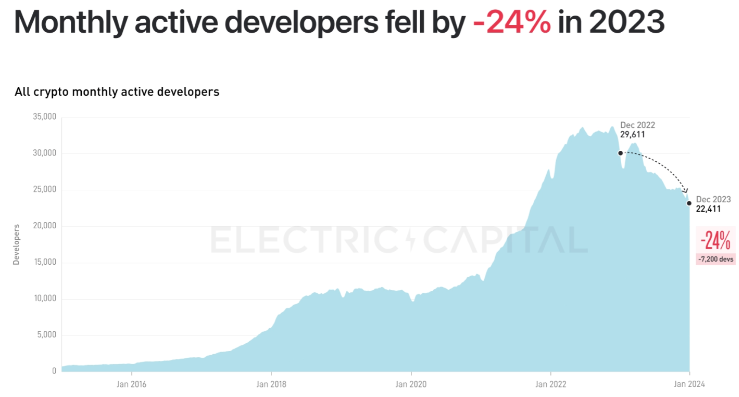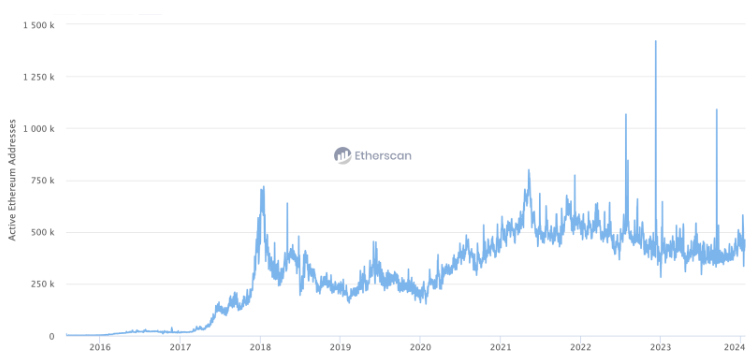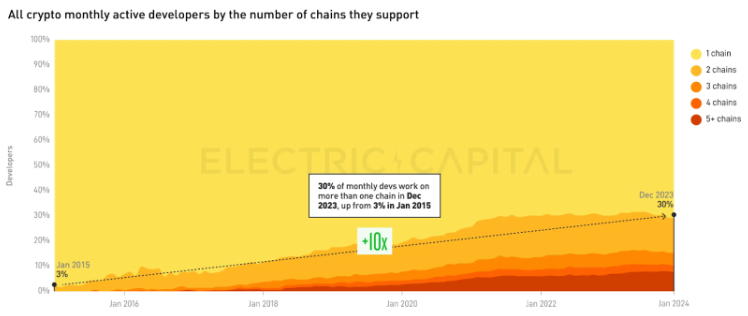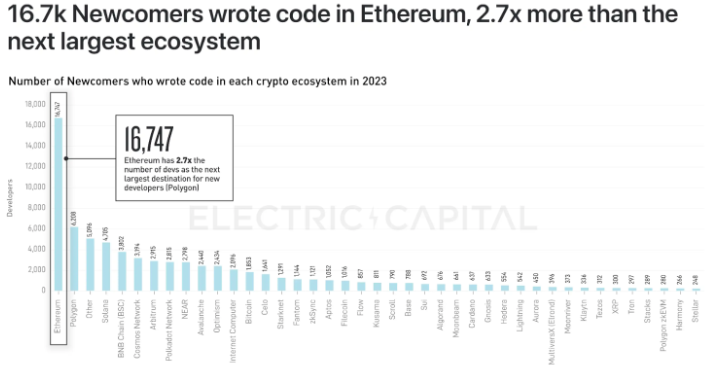Blockchain developers with one year of experience or more grew by 16% in 2023.
While crypto may be known for its rollercoaster price action, developers are joining the industry at a much steadier clip, said Maria Shen, general partner at venture firm Electric Capital, in an interview with The Defiant on Tuesday.
Blockchain developers with one year of experience or more grew by 16% in 2023, which is an increase of 1,925 in absolute terms in that time, according to Electric Capital’s Developers Report. Developers with two years-plus of experience are at an all-time high of 8,183 after growing steadily at a 52% annualized rate every year for 5 years. That’s even as overall developers dropped last year.
Developer activity is one of the most telling and measurable metrics to assess whether people are truly contributing to a blockchain or building applications on top of it. The consistent growth of experienced crypto developers tells a story of pragmatic adoption rather than the volatile prices which have attracted and lost crypto speculators in four-year cycles.
While crypto can appear like a world of fluff with little substance, to Shen, the growth of seasoned developers underscores real progress in the space.
“When you look around crypto, we’re so different from where we were in 2018,” she said, emphasizing that crypto-backed stablecoins like DAI, with its $5.2B market capitalization, were virtually non-existent five years ago.
“If you just look high level, there are these bumps, but underneath the surface the growth is actually so steady,” Shen said.
Electric Capital released the fifth Developers Report, an annual study of open-source activity in the crypto ecosystem, last week. The 181 page slideshow delves into details like developers choice of blockchains, frequency of contributions, and degrees of experience. The report has become a yearly tradition in crypto.
Total Devs Dropped
Developers working in the blockchain industry dropped by 24% in 2023 even as crypto market capitalization grew by 107% to $1.7T. A possible explanation is that developers joined crypto in the bull run of 2021 and early 2022 only to leave in 2023 as prices failed to regain all-time highs.
The fiasco surrounding FTX’s bankruptcy and other noteworthy blowups may also have tarnished crypto’s appeal, causing developers to enact plans to leave moving into 2023.
Start for free

“Newcomers join crypto across all market conditions, but some appear to be highly sensitive to prices,” Shen said, highlighting that more seasoned developers were less price sensitive.
It’s not surprising that total developers in crypto increase when prices rise and decline when prices drop, but it’s notable that more and more of them are sticking around, Shen said.
“There is some sort of fundamental draw here,” she said.
Active Addresses
To be sure, developer activity doesn’t fully encompass the state of the crypto industry. Users, and the applications that attract them, are the other side of the coin.
Going by daily active addresses on Ethereum, the dominant chain in terms of developer activity, adoption has been relatively slower. Daily active addresses have grown by roughly 8% annually from December 2018 to December 2023.
Active addresses on Ethereum hovered at 400,000 daily throughout 2023.

Measuring both developer and user activity is an inexact science — commits, which are changes made to a codebase, are not all equally important. Active addresses don’t necessarily indicate a unique user behind them as one user can have multiple addresses.
Geographic Changes
Outside of the dropoff of new developers and the growth of seasoned ones, Shen emphasized other key findings in the report. One is that crypto has moved away from an America-centric developer ecosystem. The U.S. has lost 18% of developer share since 2018 and now has only 26%, according to the report.
Shen said that regulatory uncertainty in the U.S. is a major factor that developers cited in her conversations with them. Elsewhere, interest in crypto is also growing, the investor said, highlighting Nigeria as a place of growth.
“Younger, tech-savvy Nigerians are using stablecoins to transact and use crypto almost on a daily basis,” she said. The investor cited a conversation with a Nigerian who noted that, given that he used the tech so often, it was only natural to start developing applications for it. Going multichain
Multi-Chain Direction
Another key finding of the report was that 30% of monthly active developers pushed code to multiple chains. The amount of developers pushing code three chains or more also hit an all-time high last year. “Developers have become extremely pragmatic,” she said. “A lot of them will just say that they will support any chain that has users.”

Ethereum led all blockchains with 16,747 new developers joining in 2023. Polygon was second with 6,208 and Solana was third with 4,705. Many blockchains are showing appeal however — 17 different platforms attracted over 1,000 new developers in 2023.
The investor said the Ethereum Virtual Machine (EVM), an environment for executing code that has spread to other major blockchains like Binance Chain, Avalanche, and Polygon, has made it easy to deploy applications on multiple platforms.

Faster Growth
The multi-chain trend of crypto means a few things. For one, ecosystems can bootstrap quicker. Shen highlighted how Base, the Coinbase-supported Layer 2 which launched in August and reached over 1,000 active developers by 2023’s fourth quarter.
“Having worked on this report for five years, I’ve never seen that happen,” she said. “Any new chain would take years to get to that number.”
The portability of EVM-compatible code also means that battle-tested code can be re-used. “The type of code that developers are writing and crypto is very non-trivial,” Shen said. “In a lot of cases they’re handling hundreds of millions, billions of dollars.”
With established code able to move to new blockchains, it’s easier for platforms like Layer 2s or alternative Layer 1s to establish a baseline of proven applications.
“New ecosystems have very sophisticated, very safe code right when they begin and people can build off of that,” she said.
Credit: Source link




